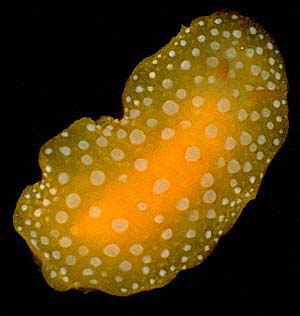
Phyllidia flava
Aradas, 1847
Order: NUDIBRANCHIA
Suborder: DORIDINA
Family: Phyllidiidae
DISTRIBUTION
Mediterranean Sea, Canary Ids.
PHOTO
6 m depth, Zaffiro Cave, Sorrentine Peninsula, Italy, May 1979, dorsal view of 20 mm specimen, Photo: R. Cattaneo-Vietti (Brunckhorst, 1993: Plate 2C).
Notes compiled from Brunckhorst, 1993:
Phyllidia flava is bright yellow with contrasting large white tubercles. Smaller tubercles are yellow. As Phyllidia flava lacks black pigmentation it is easily distinguished from all of its conspecifics. Phyllidia ocellata is the only other species with a gold background colour to the dorsum that sometimes has white capped tubercles. However P. ocellata is a large species which has black, often circular, regions on the dorsum. Ventrally, P. ocellata is coloured grey. It is the only species of Phyllidia recognised from the Mediterranean Sea.
References:
• Brunckhorst, D.J. (1993) The systematics and phylogeny of Phyllidiid Nudibranchs (Doridoidea). Records of the Australian Museum, Supplement 16: 1-107.
• Maeri, G. (1986) Notes and remarks on
Rudman, W.B., 1999 (January 12) Phyllidia flava Aradas, 1847. [In] Sea Slug Forum. Australian Museum, Sydney. Available from http://www.seaslugforum.net/find/phylflav
Related messages
Gills of Phyllidia flava
October 16, 2009
From: Marcel Tanke
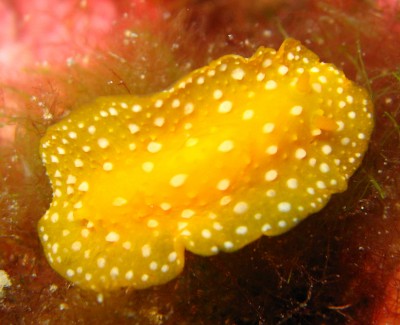
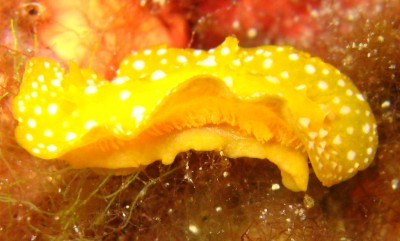
Dear Bill,
My wife and I found a Phyllidia flava on green algae(?). In the top picture the mantle is translucent and through it, the foot / body can be clearly seen. The small part on the back of the body is the anus?
When we moved to the other side of the animal we saw that it seemed to 'float' on the green algae, with the edge of its mantle raised. It was not 'mantle flapping ', just stationary.
Later at home, I was surprised to see in this picture that the gills extend to about the full left side of the body. Is this gill size normal for all Phyllidia? Do the gills extend even to the other side of the body, eg more than 180 degrees of the body 'circle'?
Locality: Porte Juan / Cannes, 20 m, France, Mediterranean Sea, 27 August 2009, Rocky bottom. Length: about 3 cm. Photographer: Marcel Tanke.
Best regards,
Marcel
marceltanke@cs.com
Tanke, M.A., 2009 (Oct 16) Gills of Phyllidia flava. [Message in] Sea Slug Forum. Australian Museum, Sydney. Available from http://www.seaslugforum.net/find/22706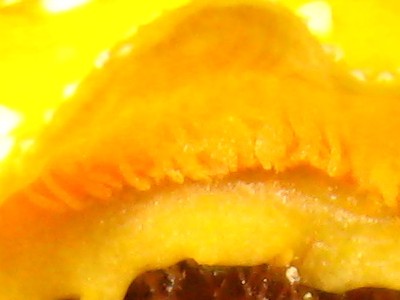
Dear Marcel,
One of the characteristics of the phyllidiids are these secondary gills which run as a band along each side of the body below the mantle skirt. Each individual 'gill' is a thin triangular leaflet. I have a photo of the gills of P. ocellata on the page discussing torsion.
It is quite difficult to photogrpah these gills in living animals because as soon as you turn them over they attempt to twist the right way up - so thanks for this photo
Best wishes,
Bill Rudman
Re: Phyllidia flava in defensive mode
May 8, 2009
From: Dominique Horst
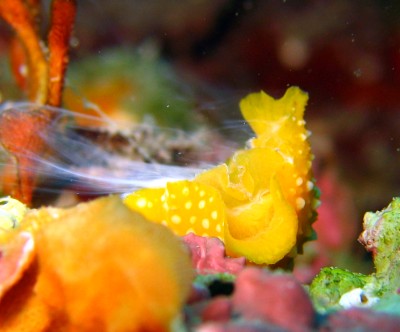
Concerning message #19807:
Hi Bill,
Apologize for this; I've pushed this Phyllidia flava a little bit. But then on the back it starts spreading a white liquid that I understand is a defense behaviour.
Locality: Antibes, 17 m, France, Mediterranean sea, 13 April 2009. Length: 2 cm. Photographer: Dominique Horst.
Kind regards,
Dominique
dominique.horst@wanadoo.fr
Horst, D., 2009 (May 8) Re: Phyllidia flava in defensive mode. [Message in] Sea Slug Forum. Australian Museum, Sydney. Available from http://www.seaslugforum.net/find/22426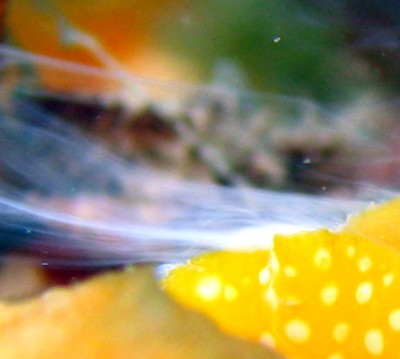
Dear Dom,
Your photo show the stringy viscous nature of the secretions phyllidiids exude when alarmed. Have a look a comment I made in response to a question about keeping phyllidiids in aquaria [message # 433].
You don't need to apologise for gently prodding animals. It often leads to interesting observations and I am sure if done with care - and not often - causes no harm.
Best wishes,
Bill Rudman
Phyllidia flava feeding
April 11, 2007
From: Dominique Horst
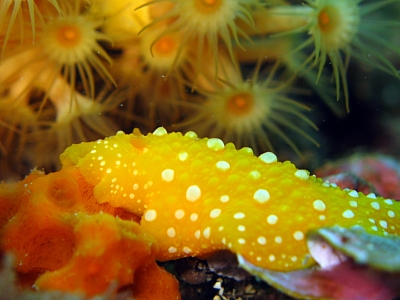
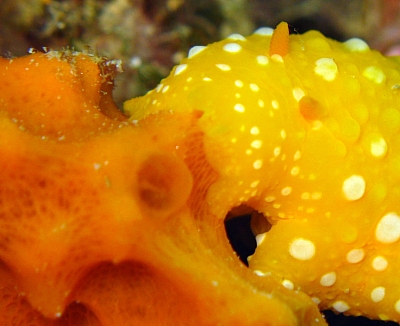
Hello,
The last sea slug I've met at lunch time, Phyllidia flava eating a sponge that should be Reniera?
Locality: Cap d'Antibes, 15m, France, Mediterranean sea, 17 March 2007. Length: 25mm. Photographer: Dominique Horst.
Kind regards,
Dominique
dominique.horst@wanadoo.fr
Horst, D., 2007 (Apr 11) Phyllidia flava feeding. [Message in] Sea Slug Forum. Australian Museum, Sydney. Available from http://www.seaslugforum.net/find/19807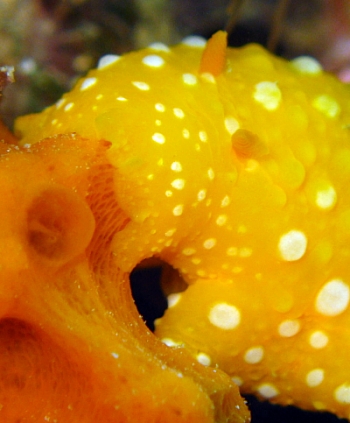
Dear Dominique,
This is a nice sequence of feeding photos. Species of Phyllidia lack radular teeth so they have to turn their food into a 'soup' by exuding digestive juices out of the mouth on to their food so they can soften it and suck it in. I think in the photo alongside you can see, near the slug's mouth, the fibre and spicule network of the sponge skeleton. This suggests that the outer layers of the sponge are being dissolved and sucked in.
I am in New Zealand at the moment so I can't check the sponge identity. Perhaps someone can help us?
Best wishes,
Bill Rudman
Re: Armina maculata or Phyllidia flava
June 1, 2006
From: Dominique Horst
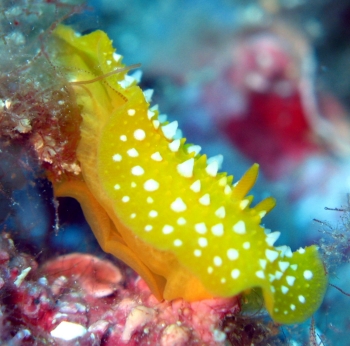
Concerning message #16713:
Many thanks for guiding me in the criteria requested to make the difference. Since I posted that message, I've met a few others and I could not resist sharing my latest pictures...
Locality: Golfe-Juan, 25m, France, Mediterranean sea, 28 May 2006, vertical rock. Length: 25-30mm. Photographer: Dominique Horst.
Kind regards,
Dominique
dominique.horst@wanadoo.fr
Horst, D., 2006 (Jun 1) Re: Armina maculata or Phyllidia flava. [Message in] Sea Slug Forum. Australian Museum, Sydney. Available from http://www.seaslugforum.net/find/16759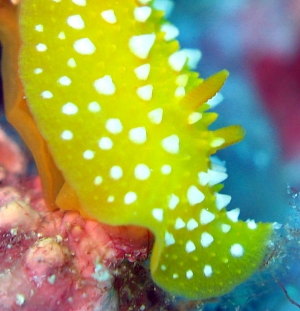
Thanks Dominique,
You can certianly see the mantle skirt around the front of the rhinophores in the close-up photo of your Phyllidia.
Best wishes,
Bill Rudman
Armina maculata or Phyllidia flava
May 31, 2006
From: Dominique Horst
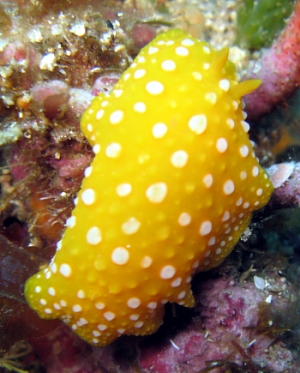
Hello,
I am confused to identify the following one. In most of books specialized in the Mediterranean sea, only Armina maculata is defined. Having a look to your site and others, it appears that Phyllidia flava fits more.
If you could help to determine which one it is, that would be great.
Locality: Port-Cros, 35m, France, Mediterranean sea, 20 May 2006, rocks. Length: 10-12mm. Photographer: Eric Poisson.
Many thanks in advance.
Dominique
dominique.horst@wanadoo.fr
Horst, D., 2006 (May 31) Armina maculata or Phyllidia flava. [Message in] Sea Slug Forum. Australian Museum, Sydney. Available from http://www.seaslugforum.net/find/16713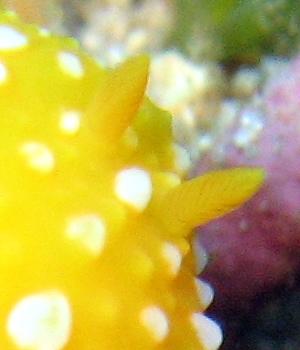
Dear Dominique,
From the general color and shape I would say this is Phyllidia flava. There are also two specific features which we can see in your photo which confirms it is not Armina. Firstly, if you look at the rhinophores [head tentacles] in the photo alongside you will see diagonal lines which indicate closely packed horizontal leaflets, charcteristic of a dorid nudibranch. In arminids, any leaflets or ridges are perpendicular. Another difference is that in dorids with a mantle skirt, the skirt goes around the front of the rhinophores, above the head as we can see in your photo [see dorid head]. In arminids, the mantle skirt stops at the level of the rhinophores.
Hope that helps
Best wishes,
Bill Rudman
Phyllidia flava from Greece
November 22, 2005
From: Vasilis Athanasopoulos
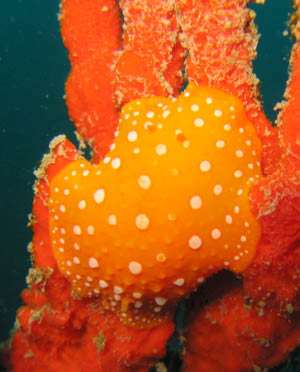
Hi,
Here is a Phyllidia flava feeding on sponge Axinella, from Greece, north Peloponeese, Panagopoula beach, between Patras and Aigio.
Locality: Panagopoula beach, North Peloponeese, Aigio, Greece. Mediterranean. Depth: 22 m. Length: 4 cm. 12 August 2005. on Axinella grown on muddy bottom. Photographer: Vasilis Athanasopoulos
Vasilis
biotechmail@gmail.com
Athanasopoulos, V., 2005 (Nov 22) Phyllidia flava from Greece. [Message in] Sea Slug Forum. Australian Museum, Sydney. Available from http://www.seaslugforum.net/find/15308Thanks Vasilis,
Bill Rudman
Phyllidia flava from Turkey
January 24, 2003
From: Ferda Buyukbaykal
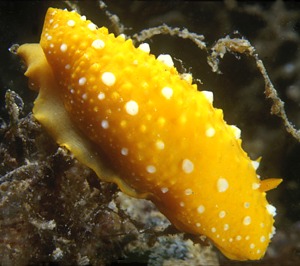
Dear Bill,
Could you identified this photo. Is it Phyllidia flava?
Image Data: Didim, Aydin, Turkey. August 2000, 12mt / 5-6cm, Algae covered rocky.
Ferda
ferdabbaykal@isnet.net.tr
Buyukbaykal, F., 2003 (Jan 24) Phyllidia flava from Turkey. [Message in] Sea Slug Forum. Australian Museum, Sydney. Available from http://www.seaslugforum.net/find/8939Dear Ferda,
Yes this is is Phyllidia flava. The 'wavy' yellow bit, on the left of the photo, is part of the foot extending out from under the mantle.
Best wishes,
Bill Rudman
Re: Phyllidia flava diet inTurkey
December 7, 2001
From: Jean Vacelet
This message has been forwarded by Bernard Picton
Dear Bernard,
The yellow sponge in Baki's photo is most probably Aplysina aerophoba. Normally
this species is eaten by another mollusk, Tylodina perversa. Aplysina is
the correct name for Verongia. Concerning the pigment, there are probably recent references, but this old one could easily be forgotten:
•Abeloos M. & Abeloos R. 1932. Sur les pigments hépatiques de Doris tuberculata Cuv. (Mollusque Nudibranche) et leurs relations avec les pigments de l'Eponge Halichondria panicea (Pall.). Comptes Rendus de la société de Biologie.
Best wishes
Jean Vacelet
Janus.Vacelet@com.univ-mrs.fr
Vacelet, J., 2001 (Dec 7) Re: Phyllidia flava diet inTurkey. [Message in] Sea Slug Forum. Australian Museum, Sydney. Available from http://www.seaslugforum.net/find/5783Dear Jean & Bernard,
Thanks for this information
Bill Rudman
Food of Phyllidia flava?
November 3, 2001
From: Baki Yokes
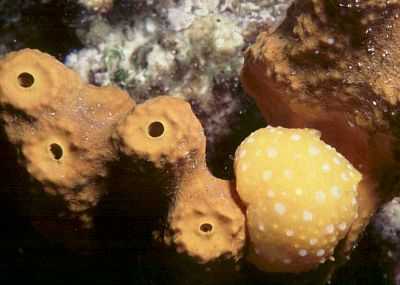
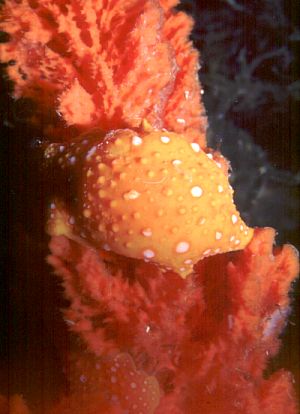
Dear Bill,
Here are photos of two different specimens of Phyllidia flava (if I'm not wrong). As far as I know, these slugs are found on sponges of Axinella sp. or Acanthella sp. These animals are mostly found in Middle and North Agean waters around Turkish coasts. The northern part is rich in Axinella and Acanthella species, but they are rarely seen in the shallow waters of Middle Agean. In these regions P. flava prefer another type of sponge. They are always orange in colour if they are found on Axinella or Acanthella, but always yellow in colour, if found on this yellow sponge. I would like to know if these animals use the pigments of the sponge they eat, and is it possible for them to change their colour if the food is changed? I will also be pleased if someone identify this yellow sponge.
UPPER RIGHT: Ayvalýk, Turkey. Divesite: Yuvarlak Ada. Depth: 10m. Size: approx. 4cm. May 1996
LOWER RIGHT: Canakkale, Turkey. Divesite: Saros Bay. Depth: 15m., Size: approx. 4cm. April 1995
Best regards
Baki
bakiyokes@turk.net
Yokes, B., 2001 (Nov 3) Food of Phyllidia flava?. [Message in] Sea Slug Forum. Australian Museum, Sydney. Available from http://www.seaslugforum.net/find/5581Dear Baki,
Some dorids, such as species of Rostanga do obtain pigments from their sponge food but i don't know if any studies have been done on Phyllidia flava. Concerning the sponge they are on - I am not a sponge expert and even less a Mediterranean sponge expert - so I make my thoughts in the form of a question. Would I be right in identifying the orange sponge in the lower photo as a species of Acanthella ? Secondly, the sponge in your upper photo looks like a species of Axinella. I think there are a number of species of Axinella, with different growth forms, so it could be possible that your mystery sponge is a species of Axinella.
Hopefully someone who knows what they are talking about will be able to enlighten us. Unfortunately sponges have many growth forms. Getting them identified is more difficult than getting gorgonians identified - and getting two sponge experts to agree is the next hurdle.
Best wishes,
Bill Rudman
Phyllidia flava feeding
June 20, 2000
From: Erwin Koehler
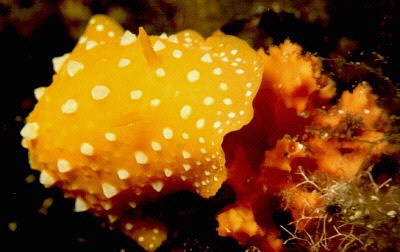
Dear Bill,
Following on Christian Desprez's question, here is a Phyllidia flava upon it's favorite prey: Acanthella acuta.
Data: size 4 cm, depth 14 m, July 07, 1997, Italy, Elba Is., divesite "yellow wall".
Erwin
Medslugs.Koehler@t-online.de
Koehler, E., 2000 (Jun 20) Phyllidia flava feeding. [Message in] Sea Slug Forum. Australian Museum, Sydney. Available from http://www.seaslugforum.net/find/2601Thanks Erwin,
Bill Rudman.
Unknown nudibranch from south of France
June 16, 2000
From: Christian Desprez
Hi Bill,
It's a long time since I gave you some news from Mediterranean Sea.
We where last week with my club at Boulouris (Var), 5 km from St Raphaël and 20 km from St Tropez. We dived at the place named " The pyramid" just in front of the tower of Dramont. And I was very excited, because I had observed two new sea slug on a sponge that I had never see before in this area or anywhere in the south of France.
Depth : 30 meters. Their size 3 x 4 cm, colour orange-yellow with on all the body some white points of an half millimeter. No eyes apparently and no external gills. Do you known this species or maybe one of your friends has some information.
Thank's in advance for your help.
Best regards.
Christian
Christian.DESPREZ@wanadoo.fr
Desprez, C., 2000 (Jun 16) Unknown nudibranch from south of France. [Message in] Sea Slug Forum. Australian Museum, Sydney. Available from http://www.seaslugforum.net/find/2580Dear Christian,
I am not an expert on the Mediterranean fauna, but if your slug had no obvious gills then it was probably Phyllidia flava. Have a look at the top of this page, above your message, for a photo and description of P. flava.
There have been a number of studies of this species in scientific journals under the name Phyllidia pulitzeri Pruvot-Fol, 1962, which is now considered an unnecessary later name for P. flava. There is a good illustrated account of this species in the Italian magazine for shell-collectors La Conchiglia with colour photos of it on one of its food sponges and laying eggs.
Reference: Maeri, G. (1986) Notes and remarks on
When disturbed this species, like most phyllidiids, exudes a milky secretion from skin glands, which is distasteful to fish. I don't know if you handled the animals you saw, but one author reports that "this animal smells disgusting" which is a reference to the smell of the defensive chemical secretion. It is reported to feed on sponges of the genus Axinella.
If you have photos it would be fairly simple for me to confirm that it is Phyllidia flava.
Best wishes,
Bill Rudman.
